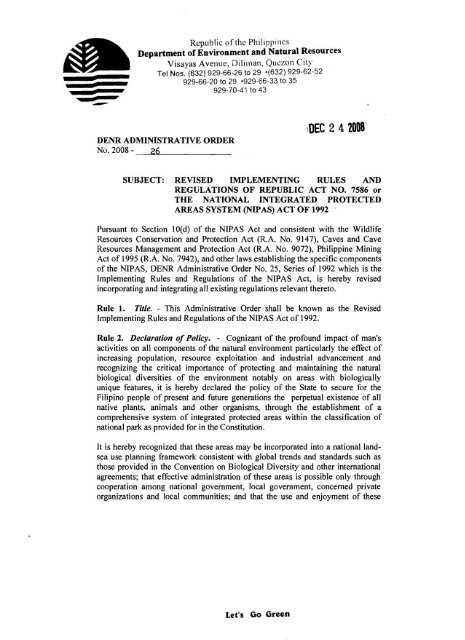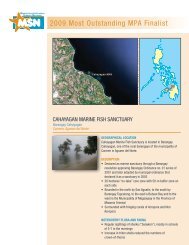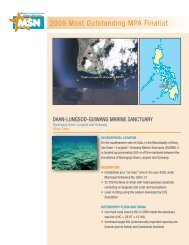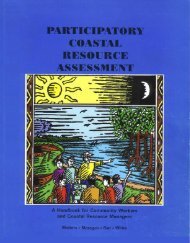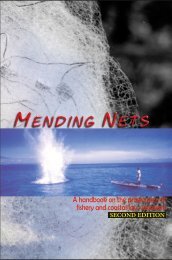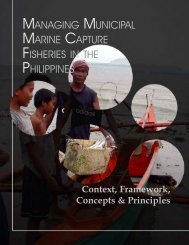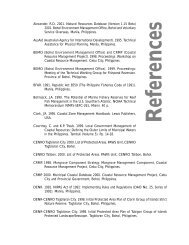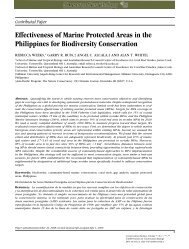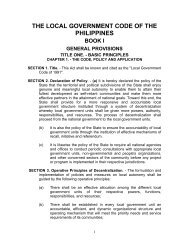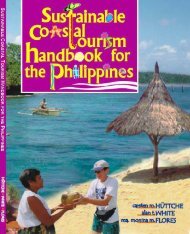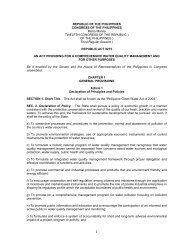DENR Administrative Order No. 2008-26 - Oneocean.org
DENR Administrative Order No. 2008-26 - Oneocean.org
DENR Administrative Order No. 2008-26 - Oneocean.org
- No tags were found...
Create successful ePaper yourself
Turn your PDF publications into a flip-book with our unique Google optimized e-Paper software.
Republic of the Philipp~nes-Department of Environment and Natural ResourcesVisayas Avenue, Diliman, Que~on CityTel <strong>No</strong>s. (632) 929-66-<strong>26</strong> to 29 *(632) 929-62-52929-66-20 to 29 0929-66-33 to 35929-70-41 to 43<strong>DENR</strong> ADMINISTRATIVE ORDER<strong>No</strong>. <strong>2008</strong> - <strong>26</strong>SUBJECT: REVISED IMPLEMENTING RULES ANDREGULATIONS OF REPUBLIC ACT NO. 7586 orTHE NATIONAL INTEGRATED PROTECTEDAREAS SYSTEM (NIPAS) ACT OF 1992 -Pursuant to Section 10(d) of the NIPAS Act and consistent with the WildlifeResources Conservation and Protection Act (R.A. <strong>No</strong>. 9147), Caves and CaveResources Management and Protection Act (R.A. <strong>No</strong>. 9072), Philippine MiningAct of 1995 (R.A. <strong>No</strong>. 7942), and other laws establishing the specific componentsof the NIPAS, <strong>DENR</strong> <strong>Administrative</strong> <strong>Order</strong> <strong>No</strong>. 25, Series of 1992 which is theImplementing Rules and Regulations of the NIPAS Act, is hereby revisedincorporating and integrating all existing regulations relevant thereto.Rule 1. Title. - This <strong>Administrative</strong> <strong>Order</strong> shall be known as the RevisedImplementing Rules and Regulations of the NIPAS Act of 1992.Rule 2. Declaration of Policy. - Cognizant of the profound impact of man'sactivities on all components of the natural environment particularly the effect ofincreasing population, resource exploitation and industrial advancement andrecognizing the critical importance of protecting and maintaining the naturalbiological diversities of the environment notably on areas with biologicallyunique features, it is hereby declared the policy of the State to secure for theFilipino people of present and future generations the perpetual existence of allnative plants, animals and other <strong>org</strong>anisms, through the establishment of acomprehensive system of integrated protected areas within the classification ofnational park as provided for in the Constitution.It is hereby recognized that these areas may be incorporated into a national landseause planning framework consistent with global trends and standards such asthose provided in the Convention on Biological Diversity and other internationalagreements; that effective administration of these areas is possible only throughcooperation among national government, local government, concerned private<strong>org</strong>anizations and local communities; and that the use and enjoyment of theseLet's Go Green
protected areas must be consistent with the principles of biological diversity,sustainable development and protection of cultural heritage.To this end, there is hereby established a National Integrated Protected AreasSystem (NIPAS), which shall encompass outstandingly remarkable areas andbiologically important public lands and ancestral domains that are habitats of rareand endangered species of plants and animals, bio-geographic zones and relatedecosystems, whether terrestrial, wetlands or marine, all of which shall bedesignated as "protected areas".2.1 The following shall be the specific policies governing theestablishment and management of the NIPAS:2.1.1 There shall be a policy of contiguousness of protectedareas and the use of police power and eminent domainto make each protected area whole, if necessary andapplicable.2.1.2 Protected areas should complement each other in termsof taxonomic representation, actual species migrationpatterns, maintenance of essential ecological processesand life support systems, and eficiency in conservationcosts.2.1.3 The management plan of protected areas shall beintegrated with the comprehensive land use plan of thelocal government units.2.1.4 The management of the NIPAS shall contribute toachievement of significant reduction in the rate ofbiodiversity loss in the short-term and help in thedevelopment of long-term targets.2.2 In order to achieve the above specific policies of the NIPAS, thefollowing strategies are hereby adopted:2.2.1 In selecting areas for inclusion in the NIPAS, theconservation priority areas in each of the identified biogeographiczones in both aquatic and terrestrialenvironments shall be primarily considered.2.2.2 The NIPAS should complement and be consistent withthe establishment, creation or designation of similarconservation areas under other relevant laws.
2.2.3 The sustainability of the NIPAS depends on thecollaboration of all stakeholders through a functional,transparent, accountable and participatory governancemechanism; the judicious use of the IntegratedProtected Areas Fund; and the development of othermechanisms for maintaining the viability of managingprotected areas prescribed under the Act.Rule 3. Scope and Coverage. - This <strong>Order</strong> shall apply to all protected areasestablished under the NIPAS and all initial components as provided in the NIPASAct, subject to Congressional enactments governing particular protected areas.This <strong>Order</strong> shall likewise set forth in detail the processes by which the <strong>DENR</strong> andother concerned institutions and agencies will establish, administer, manage anddisestablish protected areas.Rule 4. Categories and Criteria in the Determination of Appropriate Categoryof a Protected Area. - The categories and criteria herein set forth shall be used inestablishing the appropriate category of a protected area.4.1 Protected areas shall be categorized as follows:4.1.1 Strict nature reserve;4.1.2 Natural park;4.1.3 Natural monument;4.1.4 Wildlife sanctuary;4.1.5 Protected landscapes and seascapes;4.1.6 Resource reserve;4.1.7 Natural biotic areas; and4.1.8 Other categories established by law, conventions orinternational agreements which the PhilippineGovernment is a signatory.4.2 The following criteria shall be applied to determine the appropriatecategory for a proposed protected area under the NIPAS:4.2.1 Natural Features - pertain to the representativeness ofthe various ecosystems, the diversity of biota and
instruments/technologies with the intention to come up with a mapof the area;5.4 Demarcation - refers to the establishment of the boundaries of aprotected area andlor management zone using visiblemarkers/monuments, buoys in case of marine areas, and knownnatural features/landmarks, among others, as a result of the actualground delineation;5.5 Extractive resource use - refers to the removal of any naturalresources from the protected area which include, but not limited toall mining activities, commercial logging, harnessing andutilization of non-renewable energy resources, major dams andhydroelectric power projects;5.6 Household - refers to an individual or aggregate of persons,generally but not necessarily bound by ties of kinship, who residein the same dwelling unit and have common arrangements for thepreparation and consumption of food. It is necessary that theaggregate of persons should recognize one of them as the head ofthe household;5.7 Household Head - refers to member of the household who isresponsible for the care and <strong>org</strong>anization of the household or theone who is regarded as such by the members of the household;5.8 Indigenous Peoples - synonymous with Indigenous CulturalCommunities (ICCs) as defined in the NIPAS Act. As defined inRA 8371 or IPRA, it refers to a group of people or homogenoussocieties identified by self-ascription and ascription by others, whohave continuously lived as <strong>org</strong>anized community on communallybounded and defined territory, and who have, under claims ofownership since time immemorial, occupied, possessed andutilized such territories, sharing common bonds of language,customs, traditions and other distinctive cultural traits, or whohave, through resistance to political, social and cultural inroads ofcolonization, non-indigenous religions and cultures, becamehistorically differentiated from the majority of Filipinos. IPS shalllikewise include peoples who are regarded as indigenous onaccount of their descent from the populations which inhabited thecountry, at the time of conquest or colonization, or at the time ofinroads of non-indigenous religions and cultures, or theestablishment of present state boundaries, who retain some or all oftheir own social, economic, cultural and political institutions, butwho may have been displaced from their traditional domains orwho may have resettled outside their ancestral domains;
.9 Mini-hydroelectric power plant - refers to an electric-powergenerating plant which: (a) utilizes kinetic energy of falling orrunning water (run-of-river hydro plants) to turn a turbinegenerator producing electricity; and (b) has an installed capacity ofnot less than 101 kilowatts (0.1 MW) but not more than 10,000kilowatts (10 MW);5.10 Multiple Use Zone - pertains to the management zone of protectedareas where settlement, traditional and/or sustainable land-useincluding agriculture, agro-forestry, and other income generatingor livelihood activities may be allowed consistent with theManagement Plan. It also includes, among others, areas of highrecreational tourism, educational or environmental awarenessvalues and areas with existing installations of nationalsignificancelinterest such as facilities/structures for renewableenergy, telecommunication and hydro-electric power generation,among others.5.1 1 National Integrated Protected Areas System is the classificationand administration of all designated protected areas to maintainessential ecological processes and life-support systems, to preservegenetic diversity, to ensure sustainable use of resources foundtherein, and to maintain their natural conditions to the greatestextent possible;5.12 National park refers to a forest reservation essentially of naturalwilderness character which has been withdrawn from settlement,occupancy or any form of exploitation except in conformity withapproved management plan and set aside as such exclusively toconserve the area or preserve the scenery, the natural and historicobjects, wild animals and plants therein and to provide enjoymentof these features in such areas. It shall also refer to the land ofpublic domain classified as such in the 1987 Constitution whichinclude all areas under the NIPAS pursuant to R.A. 7586 primarily,designated for the conservation of native plants and animals andtheir associated habitats and cultural diversity;5.13 Natural biotic area is an area set aside to allow the way of lifesocieties living in harmony with biodiversity to adopt to modemtechnology at their pace;5.14 Natural monument is a relatively small area focused on theprotection and preservation of nationally significant naturalfeatures and biodiversity on account of their special interests orunique characteristics;
Natural park is a relatively large area not materially altered byhuman activity where extractive resource uses are not allowed andmaintained to protect outstanding natural biodiversity and scenicareas of national or international significance for scientific,education and recreational use;<strong>No</strong>n-renewable energy resources - refer to those natural resourceswithin protected areas which, if used, will be depleted and cannotbe replenished in a timescale relevant to human beings such asfossil fuels like coal, oil, petroleum, and natural gas;Protected area - refers to identified portions of land and water setaside by reason of their unique physical and biologicalsignificance, managed to enhance biological diversity andprotected against destructive human exploitation;Protected Area Occupants - refer to persons who are residing,utilizing and/or cultivating areas within the protected area;Protected Area Sub-Fund - refers to a trust fund managed by theProtected Area Management Board (PAMB) representing seventyfiveper cent (75%) of the revenues generated by the protected areafor its development and operations in accordance with the InitialProtected Area Plan (IPAP) or Management Plan;Protected landscapes/seascapes are areas of national significancewhich are characterized by the harmonious interaction of man andland while providing opportunities for public enjoyment throughrecreation and tourism within the normal lifestyle and economicactivity of these areas;Special Uses - include activities and/or developments such asecotourism, camp sites, communication, transmission, scientificmonitoring stations/facilities, irrigation canals or waterways, rightsof way, aquaculture, agro-forestry and forest plantations, amongothers, that may be allowed in the multiple use and buffer zones ofthe protected areas provided they are consistent with the IPAP orManagement Plan;Stakeholders - refer to persons or institutions that are or might beaffected in the establishment, and may contribute to themanagement and development of the protected area. It mayinclude, among others, the local government units, nationalagencies and institutions, non-government <strong>org</strong>anizations orpeople's <strong>org</strong>anizations operating in the protected area, or ICCsIIPs
and local communities living in or adjacent to the existing orproposed protected area;5.23 Strict Protection Zone - pertains to the management zones ofprotected areas consisting of natural areas with high biodiversityvalue closed to all human activities except for scientific studiesandlor ceremonial or religious use by the ICCsAPs. It may includehabitats of threatened species, or degraded areas that have beendesignated for restoration and subsequent protection, even if theseareas are still in various stages of regeneration;5.24 Survey and Registration of Protected Area Occupants - refers tothe process of detailed demographic study, assessment of socioeconomiccondition, and validation of proofs of occupancy ofmigrants living, cultivating and dependent on the resources of theprotected area for the purpose of coming up with a list of protectedarea occupants;5.25 Sustainable Use - refers to the use of components of biologicaldiversity in a way and rate that does not lead to the long-termdecline of biological diversity, thereby maintaining its potential tomeet the needs and aspirations of present and future generations;5.<strong>26</strong> Strict nature reserve is an area possessing some outstandingecosystem, features and species of flora and fauna of scientificimportance maintained to protect nature and maintain processes inan undisturbed state in order to have ecologically representativeexamples of the natural environment available for scientific study,environmental monitoring, education, and for the maintenance ofgenetic resources in a dynamic and evolutionary state;5.27 Tenured Migrant - refers to a protected area occupant who hasbeen actually and continuously occupying portion of the protectedarea subject to the provisions of Rule 15 hereof.5.28 Resource reserve is an extensive and relatively isolated anduninhabited area normally with difficult access designated as suchto protect natural resources and biodiversity of the area for futureuse and prevent or contain development activities that could affectthe resource pending the establishment of objectives which arebased upon appropriate knowledge and planning;5.29 Tenured migrant communities are communities within protectedareas which have actually and continuously occupied such areasfor five (5) years before the designation of the same as protected
areas in accordance with this Act and are solely dependent thereinfor subsistence; and5.30 Wildlife sanctuary comprises an area which assures the naturalconditions necessary to protect endemic, indigenous or migratoryspecies, groups of species, biotic communities or physical featuresof the environment where these may require specific humanmanipulation for their perpetuation;Rule 6. Establishment and Extent of the System. - The establishment andoperationalization of the NIPAS shall involve the following:6.1 All areas or islands in the Philippines proclaimed, designated or setaside, pursuant to a law, presidential decree, presidentialproclamation or executive order as national park, game refuge, birdand wildlife sanctuary, wilderness area, strict nature reserve,watershed, mangrove reserve, fish sanctuary, natural and historicallandmark, protected and managed landscape/seascape as well asidentified virgin forests before the effectivity of the NIPAS Act arehereby designated as initial components of the System. The initialcomponents of the System shall be governed by existing laws,rules and regulations not inconsistent with the NIPAS Act;6.2 All <strong>DENR</strong> records pertaining to said protected areas, includingmaps and legal descriptions or natural boundaries, copies of rulesand regulations governing them, copies of public notices of, andreports submitted to Congress regarding pending additions,eliminations, or modifications shall be made available to thepublic. These legal documents shall also be available to the publicin the respective <strong>DENR</strong> Regional Offices, Provincial Environmentand Natural Resources Offices (PENROs) and CommunityEnvironment and Natural Resources Offices (CENROs) where theNIPAS areas are located;6.3 The foregoing initial components shall be studied by the <strong>DENR</strong> forrecommendation to the President or Congress for the purpose ofestablishment under the NIPAS or disestablishment;6.4 Coastal conservation areas which are managed as fish refuges andsanctuaries pursuant to RA 8550 or the Fisheries Code and RA7160 or the Local Government Code may be established as aprotected area under the NIPAS following the requirements andprocedures as specified in these Rules.
6.5 The unique biodiversity of the area shall be the main considerationin the determination of areas for inclusion in the NIPAS. Theseareas must be representatives of a particular bio-geographic zoneandlor have one or more of the following characteristics:6.5.1 naturalness of the area to sustain ecological processesand functions and to help in climate change adaptationand mitigation such as flood minimization, amongothers;6.5.2 abundance and diversity of species of flora and fauna;6.5.3 presence of threatened andlor endemic species; and/or6.5.4 presence of unique or outstanding geological featuresthat support biodiversity.6.6 The following activities shall be undertaken in the establishment ofprotected areas under the NIPAS (Annex B):6.6.1 Preparation and Compilation of Maps withTechnical Description of Boundaries - The RegionalOffice shall prepare and compile maps with technicaldescriptions of boundaries of all protected areas,including initial components or proposed additionalareas under its administrative jurisdiction. Thetechnical description of boundaries of each protectedarea including its buffer zone shall be based on actualground survey and drawn on a map with a scale of1:50,000 for areas more than five hundred (500)hectares and 1:20,000 for areas less than five hundred(500) hectares.6.6.2 Public <strong>No</strong>tification - The stakeholders shall beinformed and properly notified of the proposedestablishment of the protected area within their locality.The Regional Office shall notify the stakeholders eitherthrough publication in newspaper of general circulation(once in a national paper) radio, television or such othermeans as deemed necessary, at least thirty (30) daysprior to the public hearing of the proposedestablishment of the protected area.6.6.3 Protected Area Suitability Assessment (PASA) - Theconcerned Regional Office shall evaluate the suitabilityof each area for inclusion under the NIPAS following
the criteria and objectives under this <strong>Order</strong> and theexisting guidelines and procedures set by the <strong>DENR</strong>.Initial components found suitable for establishment asprotected areas shall be governed by the provisions ofthe Act. Those found unsuitable shall be recommendedby the Secretary for disestablishment following theRules under Section 7.For those areas suitable for establishment under theNIPAS, the concerned Regional Office shall prepare aprofile of the protected area which shall contain theresults of the PASA and the socio-economicinformation.6.6.4 Public Consultation - Stakeholders shall be regularlyconsulted during and after the conduct of the PASA,and the gathering of socio-economic information.6.6.5 Preparation of Initial Protected Area Plan (IPAP) -Based on the results of the PASA and plans of theLocal Government Units (LGUs) and otherstakeholders, the Regional Office shall take the lead inthe preparation of the IPAP. The IPAP shall containthe following:a. rationale for the establishment of theprotected area;b. proposed boundaries including buffer zones, ifany;c. an initial designation of the strict protection andmultiple use zones specifiing the purposes,strategies and allowable uses for each zone; andd. map indicating the location of the zones.The IPAP shall serve as the basis for the planning andbudgeting and management of the protected area untilestablished through presidential proclamation or by lawand a management plan is approved by the PAMB.The Regional Development Council (RDC) shall beconsulted in the preparation of the IPAP.
6.6.6 Public Hearing - Public hearings shall be conducted toinform the public and to serve as venue for addressingissues, concerns and suggestions to the proposedestablishment of each protected area under the NIPAS.It shall be <strong>org</strong>anized by the concerned <strong>DENR</strong> FieldOffices.Public hearings shall include the following:a. <strong>No</strong>tice - The <strong>DENR</strong> shall notifjl the public ofthe proposed establishment of the protected areaunder the NIPAS through any, or a combination,of the following means: i) publication innewspaper of general circulation (once in anational daily); ii) posting of notices in themunicipal or barangay halls, and otherconspicuous public places; or iii) such othermeans deemed necessary in the vicinity, thirty(30) days prior to the public hearing to ensurethat all affected local government units,concerned national agencies, indigenous people,people's <strong>org</strong>anizations, non-government<strong>org</strong>anizations, and local communities arenotified. The concerned <strong>DENR</strong> Field Officesshall make available the information and relateddocuments to the public and shall endeavor asmuch as possible to make interpersonalcommunications or intensive information withthe general public regarding the proposedestablishment of the protected area.b. Program - The program of the public hearingmust allocate sufficient time for thepresentation, among others, of the following: i)objectives of the specific public hearing; ii)results of the PASA highlighting the rationalefor the establishment of protected area; and iii)impacts of the establishment of the protectedarea on tenure, livelihood and activities ofstakeholders, among others.c. Documentation - The following documents shallbe prepared by the concerned <strong>DENR</strong> FieldOffice as a result of the public hearing and shallbe submitted to the Secretary: i) copy of thenotices of public hearing incorporating the
additional comments, if any; ii) minutes of thepublic hearing; iii) record of attendance; iv)photos or videos taken during the hearing, ifavailable; and v) evidence of public hearing forthe establishment, if there be any, through astatement signed by stakeholders.The proceeding/results of the public hearingincluding the list of participants shall be madeavailable to the public. The public may submittheir written views on the proposed action withinthirty (30) days after the date of hearing. Theconcerned <strong>DENR</strong> Field Office shall takenecessary action on valid concerns as soon aspossible.6.6.7 Regional Review and Recommendation - TheSecretary shall create NIPAS Review Committees bothat the National and Regional Offices to lead the reviewof proposed protected areas. The Regional NIPASReview Committee (NRRC) shall be composed of theRegional Executive Director (RED) as Chairpersonwith the Regional Technical Directors of the ProtectedAreas, Wildlife and Coastal Zone Management Service(PAWCZMS), Forest Management Service (FMS) andLand Management Service (LMS), Regional Directorsof Environmental Management Service and Mines andGeo-Sciences Service as members. The RNRC inconsultation with other concerned government agenciesand RDC shall review all documents pertaining to theproposed protected area. Alldocuments/recommendations shall be endorsed by theRED to the Office of the Secretary.The endorsement shall include: i) draft PresidentialProclamation designating the area as protected area; ii)statement summarizing the rationale for itsestablishment; iii) the basic management approach; iv)map with technical description of the proposedprotected area and buffer zone including photographs orvideos of the area; v) record of public hearings; vi)certificate of concurrence of other governmentagencies, and vii) other documents as may be requiredlater during the national review.
6.6.8 National Review and Recommendation - TheNational NIPAS Review Committee (NNRC) shall becomposed of the Undersecretary for Staff Bureaus asChairperson with members as follows: Directors of theProtected Areas and Wildlife Bureau (PAWB), ForestManagement Bureau (FMB), Land ManagementBureau (LMB), Environmental Management Bureau(EMB), and Mines and Geo-Sciences Bureau (MGB),Administrator of National Mapping and ResourceInformation Authority (NAMRIA), Director of Policyand Planning Studies Office (PPSO), and the AssistantSecretary for Legal Service.The NNRC shall review the recommendations of theRegional NIPAS Review Committee and may requestthe comments and recommendations of other concernednational agencies and institutions on the proposedprotected area, if so warranted. The NNRC shall make afinal review of all the documents pertaining to theproposed protected area and shall submit itsrecommendation to the Office of the Secretary.Thereafter, the <strong>DENR</strong> shall recommend to the Office ofthe President the approval of the establishment of theprotected area under the System.6.6.9 Presidential Proclamation - Upon receipt of the<strong>DENR</strong> recommendation and supporting documents, thePresident shall make a decision whether an area will beproclaimed as protected area pursuant to the provisionsof the NIPAS Act.6.6.10 Congressional Action - All protected areas and bufferzones proclaimed by the President pursuant to theNIPAS Act shall be endorsed to Congress forlegislative enactment. Protected areas enacted byCongress shall fall under the classification of NationalParks pursuant to the Philippine Constitution.6.7 Upon enactment of the law establishing the protected area, itsboundaries shall be delineated and demarcated on the ground withconcrete monuments or other prominent physical landmarks orfeatures. Index of station numbers shall be engraved on themonuments or markers to serve as reference. Appropriate markersshall be used where the boundary of the protected area is on water.
6.8 In the establishment of protected areas, the ICCsAPs shall not bedeprived of their recognized claims and rights to the area asancestral domain or ancestral land as defined under the IPRA.6.9 When a protected area or a proposed additional area is claimed asancestral domain or ancestral land as defined under the IPRA, the<strong>DENR</strong> shall coordinate with the National Commission onIndigenous Peoples (NCIP) to ensure that the claimant ICCAP takea direct and active part in the conduct of the resource profile andpreparation of the IPAP.Rule 7. Additional Areas to be integrated to the NIPAS. - <strong>No</strong>twithstanding theestablishment of the initial components of the System, the Secretary shall proposethe inclusion in the System of additional areas with outstanding physical features,anthropological significance and biological diversity.7.1 In cases where additional areas have been identified by the <strong>DENR</strong>and indorsed to the President, the processing of applications forleasellicenselpermit of any projectlactivity therein shall be held inabeyance, except for projects that are compatible with theobjectives of the NIPAS.7.2 In the establishment of such additional areas, the procedure forestablishment of initial components shall be followed. Theidentification of such additional areas shall be based on scientificstudies and consultation with stakeholders.7.3 The establishment of additional protected areas shall not impair orprejudice prior and subsisting private rights arising from, or as aconsequence of, land use instruments issued by the <strong>DENR</strong> overportions thereof subject to the exercise of the power of eminentdomain to make the protected area whole should it becomenecessary.Rule 8. Disestablishment as ProtectedArea. - When in the opinion of the <strong>DENR</strong>a certain protected area should be withdrawn or disestablished, or its boundariesmodified as warranted by a study and sanctioned by the majority of the membersof the Management Board for the protected area as established in Section 11 ofthe NIPAS Act and these Rules, it shall, in turn, advise Congress.Disestablishment of a protected area under the System or modification of itsboundary shall take effect pursuant to an act of Congress. Thereafter, said areashall revert to the category of public forest unless otherwise classified byCongress. Provided, however, that after disestablishment by Congress, theSecretary may recommend the transfer of such disestablished area to othergovernment agencies to serve other priority programs of national interest.
8.1 Initial components which will not qualify as a protected areafollowing the Rules hereof shall be disestablished from the NIPAS(Annex C).8.2 Protected areas for disestablishment shall be supported by theresults of the suitability assessment, public notification andhearings.8.3 The <strong>DENR</strong>, with the expressed support of a majority of themembers of the PAMB if so <strong>org</strong>anized, or after consultation withthe stakeholders if a PAMB has not been <strong>org</strong>anized, shallrecommend to the President the disestablishment of a protectedarea. The <strong>DENR</strong> Secretary shall then submit the recommendationtogether with relevant supporting documents to Congress throughthe Office of the President.8.4 Protected areas disestablished shall revert to the category of forestor timberland unless otherwise classified by Congress.Rule 9. Establishment and Management of Buffer Zones. - For each protectedarea, there shall be established peripheral buffer zones when necessary, in thesame manner as Congress establishes the protected area, to protect the same fromactivities that will directly and indirectly harm it. Such buffer zones may includepublic or private lands. Prescriptions for the management of buffer zones shall beincluded as component of the individual protected area management plan. The<strong>DENR</strong> shall exercise the same authority over buffer zones in the same manner asprotected areas.9.1 Buffer zones shall be established whenever the ecological integrityof the protected area (initial component or additional area) basedon the PASA and socio-economic studies, is threatened bycircumstances such as, but not limited to, the presence of actualand potential sources of pollution; invasive species; orencroachment of adjacent communities. Other considerations mayinclude, among others, the presence of natural and semi-naturalcorridors for faunal movements andfor interchange of species.9.2 Any or a combination of the following criteria may be used in theidentification and establishment of buffer zone:9.2.1 Ecological Criteria - refer to the capability of the site toserve as an additional layer of protection by providingextension of habitats or corridors for wildlife and otherecological services.
9.2.2 Economic criteria - refer to the capacity of the site toprovide gainhl employment and sustainable alternativesources of livelihood for local communities, to deflectpressure away from the protected area.9.2.3 Social criteria - refer to the capacity of the site to provide asocial fence against the threat of encroachment bycommunities residing near or adjacent the protected area.The establishment of buffer zone as social fence entailsinterventions such as social preparation, community <strong>org</strong>anizingand empowerment to ensure its effectiveness without prejudice tothe exercise of police power if necessary.9.3 The PAMB shall exercise management authority over the bufferzones on behalf of the <strong>DENR</strong>. It shall initiate and ensureparticipatory management in the buffer zone together with theLGUs, other government agencies, NGOs, POs and otherconcerned stakeholders.9.4 The management strategy for the buffer zone shall be an integralpart of the management of the protected area. It shall be developedby the PAMB together with the concerned community and otherstakeholders following the procedures set hereof. It shall belikewise consistent with the management objectives of therespective protected area and an essential component of theManagement Plan.9.5 Rights over private lands within the established buffer zones shallbe recognized and respected in a manner consistent with theManagement Plan.Rule 10. Management Plans. - There shall be a general management planningstrategy to serve as guide in formulating individual plans for each protected area.The management planning strategy shall, at the minimum, promote the adoptionand implementation of innovative management techniques including, if necessary,the concept of zoning, buffer zone management for multiple use and protection,habitat conservation and rehabilitation, biodiversity management, community<strong>org</strong>anizing, socio-economic and scientific researches, site-specific policydevelopment, pest management, and fire control, among others. The managementplanning strategy shall also provide guidelines for the protection of indigenouscultural communities, other tenured migrant communities and for closecoordination between and among local government units, other governmentagencies as well as the private sector.
Each component area of the System shall be planned and administered to furtherprotect and enhance the permanent preservation of its natural conditions. Amanagement manual shall be formulated and developed which must contain thefollowing: an individual management plan, basic background information, fieldinventory of the resources within the area, an assessment of assets and limitations,regional interrelationships, particular objectives for managing the area,appropriate division of the area into management zones, a review of theboundaries of the area, and a design of the management programs.10.1 A General Management Planning Strategy (GMPS) shall beprepared by PAWB to serve as guide for the system-widemanagement of the NIPAS. The GMPS shall standardize themanagement planning process for protected areas to ensure: i) thatmanagement techniques provided in these Rules are adopted; ii)that national as well as international protected area managementstandards are met; iii) that there is continuity of planning efforts;and iv) that management decisions are made with inter-disciplinaryinputs and participation of all stakeholders.10.2 In the preparation of the Management Plan of protected area, thefollowing considerations shall be observed:10.2.1 Methodologies such as stakeholders' analysis, perceptionsurvey, participatory resources assessment, and communitymapping, among others, should be incorporated into theplanning process not only to generate the optimumcommunity inputs into the Management Plan but also topromote ownership of the plan by the local communities.Prior to the submission to the Secretary, the ManagementPlan shall be presented to the stakeholders through publicconsultations. The issues and concerns raised during thepublic consultations shall be addressed in the ManagementPlan. The documentary evidence of the publicconsultations shall be submitted to the Secretary throughthe PAWB by the Regional Executive Director and shallform part of the annexes of the Management Manual.The detailed planning process to be followed in thepreparation of the management plan for protected areas isshown in Annex D.10.2.2 The planning process need not be strictly sequential.Simultaneous activities may be undertaken withoutdefeating the objectives of the planning process. Theplanning process shall be consultative, iterative andinteractive particularly in the decision-making.
10.2.3 Each protected area shall have a Management Planprepared by inter-disciplinary team of experts led by the<strong>DENR</strong> Regional Office following the procedures asspecified under these Rules. The Regional ExecutiveDirector shall create and convene a Regional teamcomposed of persons knowledgeable in socio-economicplanning, land-sea use planning, ecology and protected areamanagement andlor related fields of discipline that willprovide technical assistance in the preparation of the PAmanagement plan and information management system.10.3 Each protected area shall be divided into two management zones:strict protection zone and multiple use zone consistent with itsdesignated category.10.3.1 Strict Protection Zone (SPZ) shall comprise natural areaswith high biodiversity value, closed to all human activitiesexcept for scientific studies and/or ceremonial or religioususe by the ICCs/IPs. It may include habitats of threatenedspecies, or degraded areas that have been designated forrestoration and subsequent protection, even if these areasare still in various stages of regeneration.10.3.2 Multiple Use Zone (MUZ) shall comprise areas where thefollowing may be allowed consistent with the protectedarea management plan: settlement, traditional and/orsustainable land-use, including agriculture, agro-forestry,and other income generating or livelihood activities. Itshall also include, among others, areas of high recreationaltourism, educational or environmental awareness valuesand areas consisting of existing installations of nationalsignificancelinterest such as development of renewableenergy sources, telecommunication facilities and electricpower lines.10.4 The management zones shall be demarcated using, as much aspossible, natural markers such as rivers, creeks, ridges and the like.The geographical points of the natural markers shall be verifiedand plotted using the Global Positioning System technology.All designated management zones prior to the effectivity of this<strong>Order</strong> shall be recognized. Provided, however, that in thesubsequent iteration of the Management Plan, the same shall formpart of the MUZ as defined in this <strong>Order</strong>.
10.5 Stakeholders such as tenured migrants, local government units,NGOs, POs, local communities, ICCsIIPs and other governmentagencies shall be part of the participatory decision making processin the establishment and planning of the management zones.Management objectives and strategies shall be developed for eachzone and specific approaches and technologies shall be identifiedand implemented. Provided, that the zoning of a protected areaand management prescriptions within those zones shall not restrictthe rights of ICCs/IPs to pursue traditional and sustainable meansof livelihood within their ancestral domainlland.10.6 The Management Plan shall be prepared and approved by thePAMB within three (3) years after the issuance of PresidentialProclamation establishing the protected area.The Management Plan shall have the following minimum contents:10.6.1 Description of the protected area;10.6.2 Situational analysis including key management issues andconcerns;10.6.3 Goals and objectives;10.6.4 Management strategiedinterventions;10.6.5 Description of management zones as well as majoractivities allowed/prohibited therein;10.6.6 5-year work and financial plan for the implementation ofthe Management Plan; and10.6.7 Monitoring and evaluation10.7 The annual work and financial plan of the protected area shall beprepared upon the direction of the PAMB based on theManagement Plan following the annual national governmentbudgetary cycle. Provided, that the RED shall facilitate thepreparation of plans and programs in the management of theparticular protected area.10.8 The PAMB shall ensure that the Management Plan is integratedinto the comprehensive land-sea use plans of the LGUs includingthe complementation of activities. The PAMB shall likewiseensure the harmonization of the Management Plan and theancestral domain plans of ICCs/IPs.
10.9 The Management Plan shall be approved by the majority of thePAMB and endorsed to the Secretary through PAWB. TheManagement Plan is deemed accepted unless formal writtendisapproval from the Secretary is received by the PAMB on theground of inconsistency with existing laws and related rules andregulations.10.10 The PAMB shall review and update the Management Plan at leastevery five (5) years. Any modification or revision of theManagement Plan shall follow the requirements set in these Rules.Provided, that the revised Management Plan shall be approved andendorsed in accordance with Rule 10.9.Rule 11. Administration and Management of the NIPAS. - The NIPAS ishereby placed under the control and administration of the Department ofEnvironment and Natural Resources.11.1 The <strong>DENR</strong> Secretary shall have the over-all administration andcontrol over the NIPAS. To carry out the mandate of this Act, theSecretary of the <strong>DENR</strong> is empowered to perform any and all of thefollowing acts:1 1.1 .I In consultation with the concerned LGU, to adopt andenforce an environmental plan in adjoining areas for thepreservation and control of activities that may threatenthe ecological balance in the protected areas;1 1.1.2 To cause the preparation of and exercise the power toreview all plans and proposals for the management ofprotected areas;1 1.1.3 To conduct studies in various characteristic features andconditions of the different protected areas, usingcommonalities in their characteristics, classi6 anddefine them into categories and prescribe permissible orprohibited human activities in each category in theSystem;11.1.4 To promulgate rules and regulations necessary to carryout the provisions of the NIPAS Act;
To deputize field officers and delegate any of hispowers under the NIPAS Act and other laws to expediteits implementation and enforcement;To fix and prescribe reasonable NIPAS fees to becollected fiom government agencies or any person, firmor corporation deriving benefits fiom the protectedareas;To exact administrative fees and fines for violation ofSection 21 of the NIPAS Act and other relatedguidelines, rules and regulations on protected areas andbiodiversity conservation;To enter into contracts and/or agreements with privateentities or public agencies as may be necessary to canyout the purposes of the NIPAS Act;To accept in the name of the Philippine Governmentand in behalf of NIPAS funds, gifts or bequests ofmoney for immediate disbursements or other propertyin the interest of the NIPAS, its activities or its services;To call on any agency or instrumentality of theGovernment as well as academic institutions, nongovernment<strong>org</strong>anizations and the private sector as maybe necessary to accomplish the objectives and activitiesof the System;To provide updates to Congress and Ofice of thePresident on the status of protected areas in the country;To establish a uniform marker for the System, includingan appropriate and distinctive symbol for each categoryin the System, in consultation with appropriategovernment agencies and public and private<strong>org</strong>anizations;To determine the specification of the class, type andstyle of buildings and other structures to be constructedin protected areas and the materials to be used;To control the construction, operation and maintenanceof roads, trails, water works, sewerage, fire protection
and sanitation systems and other public utilities withinthe protected area;11.1.15 To control occupancy of suitable portions of theprotected area and resettle outside of said area theoccupants therein, with the exception of the members ofthe indigenous communities area; and1 1.1.16 To perform such other fbnctions as may be directed bythe President of the Philippines, and to do such acts asmay be necessary or incidental to the accomplishmentof the purpose and objectives of the System.11.2 The respective PAMB shall be responsible for the site specificmanagement of protected areas. The PASu shall execute the plansand programs of the protected area as approved by the PAMB11.3 The PAWB shall serve as the lead bureau of the <strong>DENR</strong> for thesystem-wide planning, coordination, policy development,monitoring and evaluation, and technical assistance on protectedarea programs and projects.1 1.4 The PAWB in coordination with Public Affairs Office (PAO) shalldevelop and implement an information, education andcommunications program within three (3) months upon approval ofthis <strong>Order</strong> to inform the general public of the NIPAS, itssignificance, goals and objectives. Such program shall be utilizedas means for the public consultations and hearings to be initiatedby the <strong>DENR</strong> for the establishment and management of the NIPASas well as soliciting support for the protection of said areas.1 1.5 The RED and the Regional Technical Director (RTD) for ProtectedAreas, Wildlife and Coastal Zone Management Service shallprovide technical guidance in the management of the protectedareas under its administrative jurisdiction. The RED shall ensurethat the functional authorities among the PASu, the CommunityEnvironment and Natural Resources Officer (CENRO) and theProvincial Environment and Natural Resources Officer (PENRO)are harmonized to effectively carry out the mandate of the NIPASAct.11.6 The RED, as Chairperson of the PAMB, shall preside duringPAMB meetings. In hislher absence during meetings, the membersby highest number of votes of those in attendance, shall choosefrom among themselves a presiding officer. The RED may invite
other <strong>DENR</strong> officers to attend the meetings of the ManagementBoard as resource persons.11.7 The Protected Area Superintendent (PASu) shall bedesignatedappointed by the RED upon PAMB recommendationfrom among a short list of qualified candidates.Where the protected area encompasses substantially or whole ofthe jurisdiction of the CENRO or PENRO, the CENR Officer orPENR Officer may be designated as the concurrent PASu.In cases where the protected area straddles more than oneprovince, the PENRO of the province covering a larger portion ofthe protected area may be designated as the PASu. Helshe shallcoordinate with the other PENROs for the implementation of themanagement and development programs and activities of theprotected area and shall be directly responsible to the RED.The PASu shall be primarily accountable to the PAMB and the<strong>DENR</strong> for the implementation of the Management Plan andoperations of the protected area. Helshe shall have the followingspecific duties and responsibilities:1 1.7.1 Enforce rules and regulations to protect the area fromtrespassing, damage, vandalism and illegal occupancy.In cases of seizure, helshe shall assume custody of theapprehended items.The disposition of confiscated items shall be subject tothe clearance from the PAMB except those items thatare held under custodia legis, those that are the subjectof donation, those that must be deposited withappropriate government agency, and those that will beutilized for the <strong>DENR</strong>'s own needs in accordance withthe existing related rules and regulations;11.7.2 Issue permits for the use of facilities and amenitiesexcept for those considered as special uses as definedunder this <strong>Order</strong>;11.7.3 Issue certification whether the proposed activitylprojectis allowable or not within the management zones;1 1.7.4 Issue cutting permit for planted trees for a volume of upto five (5) cubic meters per applicant per year fortraditional and subsistence uses by ICCsIIPs and
tenured migrants only. Provided, that PACBRMAholders with affirmed Community ResourceManagement Plan (CRMP) shall no longer be issuedcutting permits. Provided further, that the total volumeof extraction does not exceed the limit set by the PAMBand the location of extraction is within the appropriatesite within the multiple use zone.1 1.7.5 Issue Certificate of Origin and/or transport permits fornatural resources and other products collected/gatheredfrom the protected area in accordance with the resourceuse instruments/agreements or gratuitous permits issuedby the PAMB and/or the <strong>DENR</strong>;11.7.6 Submit quarterly progress reports to the PAMB;11.7.7 Serve as Head Secretariat to the PAMB and itsExecutive Committee;1 1.7.8 Collect and/or receive pertinent fees, charges, donationsand other income for the protected area. Provided, thatsuch fees, charges, donations and other incomecollected/received shall be reported regularly to thePAMB in accordance with the existing guidelines;11.7.9 Prepare and recommend to the PAMB approval of theannual work and financial plans of the protected areabased on the IPAP or the Management Plan;11.7.10 Develop management information system to ensure thatrelevant and updated information are available forplanning, monitoring and decision-making; and11.7.11 Perform other relevant functions that the RED orPAMB may delegate.11.8 The PASu shall, whenever practicable, be assisted by technical andsupport staff to perform the day to day management, protectionand administration of the protected area. The PASu may delegatethe authority provided herein to hisher staff.Whenever applicable, the site level staff shall be recruited fromresidents living within or in the immediate vicinity of the protectedarea.
Rule 12. Protected Area Management Board - A PAMB for each of theestablished protected area under the NIPAS shall be created. For initialcomponents of the NIPAS, the PAMB shall be created once the area has beendetermined to be suitable for inclusion to the System. For additional sites, thePAMB shall be created after the issuance of Presidential Proclamationestablishing the area under the NIPAS.12.1 The functions of the PAMB shall be as follows:12.1.1 Approve policies, guidelines, plans and programs,proposals, agreements and other related documentsincluding the Manual of Operations for themanagement of the protected area;12.1.2 Facilitate the ground delineation and demarcation of theboundaries of the protected area and buffer zone;12.1.3 Ensure that the Management Plan of protected area andthe Ancestral Domain Sustainable Development andProtection Plan (ADSDPP) are harmonized;12.1.4 Ensure the implementation of programs as prescribed inthe Management Plan of protected area;12.1.5 Monitor and evaluate the progress in theimplementation of the Management Plan including theharmonized plans with ADSDPP;12.1.6 Monitor and assess the performance of the PASu andother protected area personnel and compliance ofpartners to the terms and conditions of any undertaking,contract or agreement;12.1.7 Resolve conflicts or disputes among tenured migrantcommunities, between tenured migrant communitiesand ICCsAPs but excluding conflicts or disputesexclusively among ICCsAPs; and12.1.8 Recommend fees and other charges to the Secretary forthe use of the protected area; and12.2 The composition of the PAMB shall be made final upon theenactment of the law placing the protected area under the NIPAS.The PAMB shall be composed of the following:
12.2.1 The RED as Chairperson and advisor on matters relatedto the management of the protected area.In cases where the protected area straddles more thanone region, the RED of the region covering the largerportion of the protected area may be designated as theChairperson of the Management Board. Helshe shallcoordinate with the other RED(s) for theimplementation of the management and developmentprograms and activities of the protected area.12.2.2 One representative of the Autonomous RegionalGovernment, if applicable;12.2.3 The Provincial Planning and Development Coordinatorfrom each province with territory within the protectedarea;12.2.4 One representative from each of the Municipalitycovering the protected area;12.2.5 One representative from each of the Barangay coveringthe protected area;12.2.6 One representative from each tribal community withinthe protected area as certified and endorsed by theNCIP, if applicable;12.2.7 At least three (3) but not more than five (5)representatives from local NGOs and community<strong>org</strong>anizations, including people's <strong>org</strong>anizations, churchor civic <strong>org</strong>anizations and the academe; and12.2.8 One representative each, if necessary, from otherdepartments or national government agencies involvedin the protected area.12.3 The Secretary shall appoint the members of the PAMB. The REDand the Provincial Planning and Development Coordinator(s) shallserve ex-officio members of the PAMB.For PAMB representatives other than the Mayors and PunongBarangays, their appointment as such shall be supported by aSanggunian Resolution.
ICCs/IPs within the protected area shall nominate itsrepresentatives to the PAMB following their customary laws andpractices. Such nomination shall be validated and confirmed bythe NCIP.Representatives of NGOs and POs shall be endorsed by theirrespective heads of the <strong>org</strong>anizations. Should there be NGOPOconsortia in the area, each consortium shall be entitled to one (1)representative to the Management Board. Provided, that the totalNGOPO representation to the Management Board shall not exceedtwenty-five per cent (25%) of the total membership of the PAMB.Provided, further, that the qualified NGOs/POs shall choose amongthemselves the <strong>org</strong>anizations who would sit in the PAMB. Hence,NGO/PO consortium members shall no longer be eligible forrepresentation to the PAMB.Such NGO, PO and/or consortia must be: i) known to be withinterest, integrity and commitment to the conservation of naturalresources; and ii)locally-based and legally existing continuouslyfor at least three (3) years prior to the proposed appointment to thePAMB.12.4 The members of PAMB shall serve for a term of five (5) yearswithout compensation, except for actual and necessary travelingand subsistence expenses incurred in the performance of theirduties. Provided, that whenever a vacancy occurs during the termof a member, a new member shall be appointed in the samemanner as the original appointment in order to complete theunfinished term of the said vacancy.In case of elective officials, the term of office as ManagementBoard member shall be co-terminus with hidher position.Provided, that the incoming elective official may opt to allowcontinuity of representation by the previous elective officialthrough a Sanggunian Resolution which shall be communicatedofficially to the PAMB.12.5 The PAMB En-banc may create an Executive Committee and othercommittees to effectively cany out its functions.The Executive Committee shall be composed of the following:12.5.1 Regional Executive Director as the Chairperson;12.5.2 One (1) representative from the Autonomous RegionalGovernment, if applicable;
12.5.3 At least one (1) representative from the Provincial andMunicipal Governments;12,5,4 One (1) representative from NGOsIPOs; and12.5.5 At most three (3) representatives from IPS.The Management Board may call on representatives from othergovernment agencies concerned.The Management Board shall determine the authorities to bedelegated to the Executive Committee.The PAMB may likewise create other committees as may benecessary to effectively implement the Management Plan and thefunctions of the PAMB.12.6 The PAMB en-banc shall meet at least twice a year.12.7 The notices of meetings of the PAMB and Executive Committee aswell as the proceedings of such meetings shall be prepared by thePASu as Secretariat of the PAMB.The PAWB shall be provided with a report of the highlights of themeetings within seven (7) days after each meeting for purposes ofmonitoring and providing advice and policy directions on protectedarea management.12.8 A member of the Management Board may be removed for any ofthe following grounds:12.8.1 More than three (3) consecutive unexcused absencesduring regularly scheduled meetings of theManagement Board;12.8.2 Commission of acts prejudicial to the management ofprotected areas as embodied in Section 20 of theNIPAS Act or other existing rules and regulationsgoverning protected areas;12.8.3 Disassociation from the office or <strong>org</strong>anization beingrepresented;12.8.4 Dissolution of the office or <strong>org</strong>anization beingrepresented; and
12.8.5 Conviction by final judgment of any criminal act.12.9 The PAMB shall formulate specific policy on disciplinarymeasures for habitual absentee ex-officio members.12.10 The PAMB shall promulgate internal rules governing theresolution of any dispute or claim filed before them. All decisionsof the PAMB may be appealed to the <strong>DENR</strong> Secretary. Provided,that the Secretary can reverse or modify a decision of the PAMBonly on the grounds that the same violates existing laws, rules andregulations or is contrary to the Management Plan.Rule 13. Environmental Impact Assessment. - Considering that protected areasare Environmentally Critical Areas (ECA), the proponent of development projectsand activities with potential environmental damage as determined byEnvironmental Management Bureau, whether or not included in the ManagementPlan, shall secure an Environmental Compliance Certificate (ECC) in accordancewith the Philippine Environment Impact Statement (EIS) System. Provided, thatfor development project and activity within the Management Plan, an InitialEnvironmental Examination (IEE) can be undertaken instead of a full-blownEnvironmental Impact Assessment (EIA).13.1 The proponent of development project and activity shall secureprior clearance from the PAMB before undertaking orimplementing the activity and before the issuance of an ECC.13.2 Violations of environmental laws, rules and regulations, includingthose under the EIA System, shall be penalized accordingly.Rule 14. Ancestral Lands and the Rights of ICCsAPs. - The <strong>DENR</strong> incollaboration with the PAMB shall assist the NCIP in the identification,delineation and recognition of the claims of ICCsIIPs to their ancestraldomainlland within protected areas following the provisions of RA 8371 or theIPRA.14.1 In the establishment of protected areas, the <strong>DENR</strong> shall ensure thefull participation of the concerned ICCs/IPs in accordance withNIPAS Act and the IPRA.The ancestral domain within a protected area shall be managed inaccordance with a plan harmonized with the Protected AreaManagement Plan. Unless the ICC/IP submits a written notice ofits intent to manage the protected area, the <strong>DENR</strong> and PAMB shallmanage the protected area. In any case, the ICCIIP shall enjoy fulland effective assistance of the concerned PAMB.
The customary rights and traditional practices of ICCsIIPs shall berecognized and respected.14.2 Interested ICCsAPs may participate in the community-basedprogram in protected areas following the procedure in Annex E.Rule 15. Tenured Migrants. - A survey and registration of occupants of theinitial components and proposed additional areas for inclusion to the NIPAS shallbe undertaken for management planning and issuance of tenurial instruments toqualified occupants. The survey shall include a detailed demographic study,assessment of socio-economic conditions and validation of proofs of occupancy.The Secretary, by subsequent regulations, shall establish the procedures for theconduct of the survey and registration of occupants of protected areas.15.1 The household head shall be considered a tenured migrant ifproven to have actually and continuously occupied a portion of theprotected area for five (5) years before its designation as protectedarea and solely dependent therein for subsistence. Solelydependent for subsistence is when everything indispensable forsurvival for the household, including food, clothing, shelter andhealth, comes only from the utilization of resources from theprotected area.15.2 A Certificate of Recognition shall be issued to those who qualifyas tenured migrants based on the Rules provided hereof. Thereckoning period of five (5) years to qualify as tenured migrantshall be:15.2.1 For initial components of the NIPAS, August 5, 1987 orfive (5) years prior to the effectivity date of the NIPASAct.In case the initial component is expanded, thereckoning date for recognition of tenured migrants shallbe five (5) years prior to the recent proclamation.15.2.2 For additional areas of the NIPAS, five (5) years priorto the Presidential Proclamation or Congressionalenactment establishing the protected area, whichever isearlier.In case of expanded additional areas, the reckoning datefor recognition of tenured migrants shall be five (5)years prior to the original proclamation.
15.3 Physical structures indicating prolonged occupancy or Certificationunder oath from the Barangay Chairperson or any two (2)respected members of the nearest community attesting to theoccupancy and any two or more of the following shall beconsidered as proofs of occupancy:15.3.1 Planted trees;15.3.2 Inventory report of forest occupants of concernedgovernment agencies, if available; and15.3.3 Other relevant documents to prove occupancy.15.4 The <strong>DENR</strong>, upon the recommendation of the PAMB shall enterinto Protected Area Community-based Resource ManagementAgreement (PACBRMA) with the tenured migrant communities ofprotected areas.The <strong>DENR</strong> shall endeavor to integrate individual tenured migrantsinto communities.Within one (1) year from the issuance of the PACBRMA, tenureholders shall be required to prepare a Community ResourceManagement Plan (CRMP) based on the procedure herein provided(Annex F). Failure to implement the CRMP shall serve as basisfor the cancellation of the agreement.In the event of cancellation of PACBRMA for cause or byvoluntary surrender of rights, the PAMB shall take immediatesteps to rehabilitate the area.For cancellation of PACBRMA for reasons of public interest asdetermined by the <strong>DENR</strong> Secretary, the affected tenured migrantsshall be accorded just compensation based on the fair market valueof the improvements and shall be granted the right to a substitutesite.15.5 Tenured migrants communities located within the Strict ProtectionZone shall be resettled to the Multiple Use Zone or Buffer Zone.Protected area occupants who do not qualifL as tenured migrantsshall be resettled outside the protected area. The PAMB incoordination with the LGU concerned shall implement a definiteschedule for resettling them outside the protected area.Rule 16. Survey for Energy Resources. - Consistent with the policies declared inSection 2 of the NIPAS Act, protected areas, except strict nature reserves and
natural parks, may be subjected to exploration only for the purpose of gatheringinformation on energy resources and only if such activity is carried out with theleast damage to surrounding areas. Surveys shall be conducted only inaccordance with a program approved by the <strong>DENR</strong>, and the result of such surveysshall be made available to the public and submitted to the President forrecommendation to Congress. Any exploitation and utilization of energyresources found within NIPAS areas shall be allowed only through a law passedby Congress.16.1 Exploration for utilization of energy resources shall not be allowedin Strict Nature Reserve and Natural Park categories. Inaccordance with the management objectives for strict protectionzones as designated in other categories of protected areas,exploration of energy resources shall likewise be prohibited.16.2 Survey of non-renewable energy resources within protected areasshall be allowed only as part of the resource profiling of theprotected area as provided under Rule 6.16.3 The exploitation and utilization of non-renewable energy resourcesfound within protected areas except Strict Nature Reserves andNatural Parks shall be allowed only through a law passed byCongress.16.4 The development, utilization and operations of non-extractiverenewable energy sources such as wind, solar, or tidal energy, andnot more than three (3) megawatts capacity for mini-hydro power,shall be allowed in protected areas other than Strict NatureReserves and Natural Parks through the issuance of appropriateinstruments in accordance with existing laws and regulations.Provided, that these renewable energy projects are outside the strictprotection zones, reduced impact technologies shall be adopted andthe operation of such shall be in accordance with the EIS System.Rule 17. Areas Under the Management of Other Departments and GovernmentInstrumentalities. - The <strong>DENR</strong> shall retain jurisdiction over all protected areas inaccordance with Executive <strong>Order</strong>s <strong>No</strong>. 192 and 292. The <strong>DENR</strong> has management andadministration over NIPAS except those placed under the management andadministration of other agencies pursuant to specific laws or presidential issuances.Provided, That the department or government instrumentality exercisingmanagement and administration over said protected area or a portion thereof shallcoordinate with the <strong>DENR</strong> in the preparation of its management plans.The <strong>DENR</strong> may enter into an agreement with the concerned government agencyfor the management of the protected area specifically for activities such as the
creation of a management body, preparation of the management plan, and otherrelated activities.Rule 18. Integrated Protected Areas Fund - There is hereby established a trustfund to be known as Integrated Protected Areas (IPAS) Fund for purposes offinancing projects of the NIPAS. The <strong>DENR</strong> may solicit and receive donations,endowments, and grants in the form of contributions, and such endowments shallbe exempted from income or gift taxes and all other taxes, charges or feesimposed by the Government or any political subdivision or instrumentalitythereof. All incomes generated from the operation of the NIPAS and itscomponent protected areas shall accrue to the Fund and may be utilized directlyby the <strong>DENR</strong> for the above-mentioned purposes.18.1 The income for the IPAF shall be derived from:18.1.1 Fees from the permitted sale and export of flora and faunaand other resources derived from protected areas;1 8.1.2 Proceeds from lease of multiple-use zones;18.1.3 Contributions from industries and facilities directlybenefiting from the protected area; and18.1.4 Such other fees and incomes derived from the operation ofthe protected area.18.2 Disbursements from the Fund shall be made solely for theprotection, maintenance, administration, and management of theSystem, and duly approved projects endorsed by the PAMBs, inthe amounts authorized by the <strong>DENR</strong>.18.3 The PAMB in coordination with other government agenciesconcerned shall recommend to the Secretary reasonable fees to becollected from government agencies or any person, firm orcorporation deriving benefits from the protected areas.18.4 All revenues generated by the protected areas shall be deposited astrust account to be maintained by the <strong>DENR</strong> in any authorizedgovernment depository bank. The Fund shall be set up to operateboth Central IPAF at the national level and the Protected AreaSub-Fund at the site level.18.5 All contributions, endowments, donations and grants to a specificprotected area shall accrue solely to the concerned Protected AreaSub-Fund through the RED.
18.6 The PAMB shall monitor the collection, accounting and deposit ofincome into the Protected Area Sub-Fund.18.7 Upon the recommendation of the PAMB and subject to existingaccounting and auditing rules and regulations, the RED shalldesignate a Special Collecting Officer (SCO) whose mainresponsibilities are to collect all revenues and donations to theprotected area and to submit a monthly accounting report to thePAMB.18.8 The <strong>DENR</strong> Regional/Provincial Accountant nearest to theconcerned protected area shall maintain the book of accounts.Reports of collection and deposit and copy of the deposit slipsshall be submitted to PAWB for information and monitoring.18.9 The use and disbursement of the IPAF shall be guided by thefollowing:18.9.1 Central IPAFa. Upon the recommendation of the PAWB Director,the <strong>DENR</strong> Secretary shall decide on the fundallocation from the Central IPAF in accordancewith its allocation criteria.b. Request for funding assistance from the CentralIPAF shall be supported by the following minimumrequirements:i. Duly approved Work and Financial Plan(WFP) for the proposed project or activityby the PAMB Chairperson;ii.iii.iv.Project Proposal with justification for therequest;PAMB Resolution approving the ProjectProposal and Work and Financial Plan(WFP); andAccomplishment Report of those withprevious request.The above-mentioned requirements shall besubmitted by the PAMB through proper channels to
the RED who shall endorse the same to PAWB forevaluation and appropriate action.The detailed process for the utilization of theCentral IPAF is in Annex G.18.9.2 Protected Area Sub-Funda. The Protected Area sub-~und can be availed by theconcerned protected area upon submission of thefollowing to the RED:1. Duly approved WFP;ii.iii.iv.Project Proposal including the detailedbreakdown of expenditures;PAMB Resolution approving the projectproposal and WFP; andAccomplishment Report of those withprevious request.b. All documents mentioned above shall be forwardedto the concerned PENRO.c. The concerned Accountant shall prepare an updatedtrial balance of the agency supported by copies ofthe bank deposits from the authorized governmentdepository bank and submit the documents to theRED for approval through endorsement of thePENRO.d. <strong>No</strong> disbursement shall be processed withoutsubmission of all the required documents.e. A copy of the approved WFP with the abovementionedrequirements shall be forwarded toPAWB for information, review and monitoring.f. Reports of actual disbursement of funds shall besubmitted to PAWB on monthly basis forinformation, consolidation and monitoringpurposes.
The detailed process for the utilization of Protected AreaSub-Fund is shown in Annex H.18.10 Pursuant to COA Circular Letter <strong>No</strong>. 2003-005 dated 2 1 <strong>No</strong>vember2003, the following shall be the procedure for the collection,deposit and utilization of contributions, endowments, donationsand grants for protected areas:18.10.1 The <strong>DENR</strong> Secretary or the PAWB Director or theRED as Chairperson of the PAMB may receivedonations, endowments, contributions and grants forspecific purposelintent of the protected area. Provided,that such contributions, endowments, donations andgrants shall be deposited in a trust account in the nameof the protected area with authorized governmentdepository bank.18.10.2 All contributions, grants and donations shall beproperly covered by Deeds of Donation.. .18.10.3 For contributions, endowments, donations and grantsfor the NIPAS, a WFP shall be prepared in accordancewith the Deeds of Donation. For contributions,endowments, donations, and grants for specificprotected area, a WFP shall be prepared in accordancewith the Deeds of Donation for the approval of thePAMB. The WFP shall be the basis for theA.disbursement of such funds.Rule 19. Field OfJicers. - All officials, technical personnel and forest guards orpark rangers employed in the protected areas or all persons deputized by the<strong>DENR</strong>, upon recommendation of the Management Board shall be considered asfield officers. Such field officers shall have the authority to investigate and searchpremises and buildings and make arrests in accordance with the rules on criminalprocedure for the violation of laws and regulations relating to protected areas.Persons arrested shall be brought to the nearest police precinct for investigationand filing of appropriate charges.<strong>No</strong>thing herein mentioned shall be construed as preventing regular law enforcersand police officers from arresting any persons in the act of violating the laws andregulations related to protected areas and biodiversity conservation.Rule 20. Special Prosecutors. - The Department of Justice shall designate specialprosecutors to prosecute violation of laws, rules and regulations in protectedareas.
Rule 21. Prohibited Acts. - Except as may be allowed by the nature of theircategories and pursuant to rules and regulations governing the same, the followingacts are prohibited within protected areas:2 1.1 Hunting, destroying, disturbing, or mere possession of any plantsor animals or products derived from the protected areas without apermit from the Management Board;21.2 Dumping of any waste products detrimental to the protected area,or to the plants and animals or inhabitants therein;21.3 Use of any motorized equipment without as permit from theManagement Board;2 1.4 Mutilating, defacing or destroying objects of natural beauty, orobjects of interest to cultural communities (of scenic value);2 1.5 Damaging and leaving roads and trails in a damaged condition;2 1.6 Squatting or otherwise occupying any land;2 1.7 Mineral locating within protected areas;21.8 Constructing and maintaining any kind of structure, fence orenclosures, conducting any business enterprise without permit;2 1.9 Leaving in an exposed or unsanitary conditions refuse or debris, ordepositing in ground or in bodies of water; and2 1.10 Altering, removing, destroying or defacing boundary mark orsigns.Rule 22. Penalties. - Whoever violates the NIPAS Act or any rules andregulations issued by the Department pursuant to the NIPAS Act or whoever isfound guilty by a competent court of justice of any of the offenses provided in theNIPAS Act and this <strong>Order</strong> shall be fined in the amount of not less than Fivethousand pesos (P5,OOO) nor more than Five hundred thousand pesos (P500,000),exclusive of the value of the thing damaged or imprisonment for not less than one(1) year but not more than six (6) years, or both, as determined by the court:Provided, That, if the area requires rehabilitation or restoration as determined bythe court, the offender shall also be required to restore or compensate for therestoration of the damaged areas. Provided, further, that the court shall order theeviction of the offender from the land and the forfeiture in favor of theGovernment of all minerals, timber or any species collected or removed includingall equipment, devices and firearms used in connection therewith, and anyconstruction or improvement made thereon by the offender. If the offender is an
association or a corporation, the president or manager shall be directly responsiblefor the act of his employees and laborers. Provided, finally, that administrativefines and penalties may be imposed upon the recommendation of the PAWB inconsultation with the concerned PAMBs and the <strong>DENR</strong> Regional Ofices.The above penalties shall be imposed without prejudice to the application of otherexisting laws, rules and regulations.Rule 23. Separability Clause. - If any part of this <strong>Order</strong> is inconsistent with anyprovisions of other laws, its implementatiori shall be deferred until such time thatsuch laws are amended.Rule 24. Repealing Clause. - All issuances inconsistent with this <strong>Order</strong> arehereby deemed repealed.Rule 25. Effectivity Clause. - These Revised Implementing Rules anRegulations shall take effect fifteen (15) days upon filing with the Ofice oftNational <strong>Administrative</strong> Register andfor publication in a national newspapergeneral circulation.RwUc of tho PhillpplnssIN REPLTlNG. PLS CITE:Revised IRR NIPAS Act10 <strong>No</strong>vember <strong>2008</strong>Publication: MalayaJanuary 16, 2009Registration. ONAR, U.P. Law CenterJanuary 16, 2009
Annex A. Protected Area CategoriesCRITERIAI. Natural FernStrict Nature Reserve(SNR)Area with biodiversity richnatural ecosystems in anundisturbed state.Natural Park (NP)Relatively large biodiversityrichmsystems; capable ofsustaininglmainteinhgecologicalp~slfundonsNatutnl Monument(NM)Nationally significantnaturalfmres of cultural <strong>org</strong>eologicvalueProtected Area CategoryWildlife Sanctuary (WS)Habitat of a ~pecies or a groupofspecies of prioritymanagementconcernHabitat of important wildlifespecies (endemic andthreatmed) as indicatedby species assemblage (e.g.EndemicBird Area, Important BirdAreaImportant Plant Area)Protected LandscapesSeascnpcs (PUS)Arcas of national significancewhich arc charaaerized bythe harmonious interaction ofhumsn and natureResource Reserve (RR)Extensive and relativelyuninhabited isolated andiasoccssible rsource baseNatural Biotic Area(NBA)Ateas of extensive culturalsignificance; indigenouspeoples and otha localcommunities living in harmonywith their environmentpndcing their culture wdtradibons2. ManagementObjective (s)Research and scientificstudiesenvironmental monitoringconservation educationmaintenance of geneticresources and naturalecological processesBiodiversity conservation andmaintenance of nshvalecological processesNature recreation,Research & ximtificStudiesEnvironmental monitoringConservation andprotection of specificnsrural featuresRotdoa and conservation ofwildlife and their habitatProtection of natural features andproviding opportunitiesfor sustainable resource useConservation and protection ofnatural resources for future useProtection and cowation ofculture/customs and haditionsof Indigenous Peoples (Ps)and otha local communitiesandtheir environment includingrrsourccs3. Allowable HumanActivities*Limited scientific researchi.e. coun& observations,and meamrements at thesite and non-extractiveresearch and educationalactivitiesNature recreationRegulated resource use,consistent with managementplan EXCEPT tuning ofnaturally growing treessubject to PAMB clearanceEwtourisnScientific research withregulated collection ofspecimensScientific research withregulated eolledon ofspecimensNature recreationRegulated resource useEXCEPTthose thm are essential toconservation of the speciesbeing munaged wd cutting ofnaturally growing treesSustainable socio-economicactivities and traditional practicesRegulated resource use EXCEPTcutting of naturally growing trees.However .cutting of naturallygrowing heff for p~sonal andnoncommercial use of trnuredmipants may be allowed,subject to allocation criteriaprescribed by PAMBResearch and scientific studiesBiodiversity monitoringTrnditional and sustainableresource use* In all categories, the customary rights and traditional practices of Indigenous Peoples shall be recognized, respected and allowed subject to the Wildlife Resources Conservation & Protection Act (RA 9147) andother applicable laws, rules and regulationsMining is prohibited in all protected areas regardless of categories pursuant to the Mining Act of 1995 (RA 7942)
Annex B - Procedure for the Establishment of Protected AreasOther information from1Preparation of ResourceProfilePASA & SRPAOPreparation ofCInitial PA Plan 0NRegionalReview RecommendationrNationalReview RecommendationSULTATwPresidentialProclamationvCongressionalEnactment -I0N
Annex C - Procedure for Protected Area Dis-esta blis hmentProclamationEnactment
Annex D - PA Management Planning ProcessData inlrsndory and information cdlectionldentlllcatbn at Issues, concern and netmume useopportunities, & stakeholdersInstitutionalDswlopment of goals and objectivssDrafthg of managamant plan+Flnallzatlon of the plan+Monitoring & Evaluation-IDevelopId* and ddlWmimqmd amat &dwdoprssowce&sociwconomiclmdvMmanaOementrdandards, guidelinesprercriplions &programs
PROTECTED AREA COMMUNITY-BASED RESOURCE MANAGEMENT AGREEMENTISSUANCE (PACBRMA) DAO 2004-32Peoples Organization(Qualified tenured migrants)Applicant filesapplication and submitsRequirements to PASuPASU reviewsapplication andendorse to PAMB(within 15 days))PAMB-CBP Committeediscuss the termsand conditions with POand endorse to RED(within 30 days)Approval of the<strong>DENR</strong> Secretary
Annex G - Central IPAF UtilizationDisbursement 7VouchersPAWB DirectorWork & Financial1. Certificate of2. Breakdown ofthe PAMB3. Monitors andcollections and
Annex H - PA Sub-Fund UtilizationDisbursementPAWB Directorbalance of theFinancial Plan2. Breakdownof Expensesaccording tothe describedformat.3. Resolutionby the PAMBapproving theproj.propJIMIF P;4.AccomplishmentReportthe Bankdeposit slips.3. Request forthe utilization ofthe trust fund2. Forward copyof the approvedWFP andcorrespondingdocuments toPAWB3. Report ofactualdisbursements offunds.2. Monitors therevenues andthe actualdisbursements offunds2. Updatedatabase onIPAF


